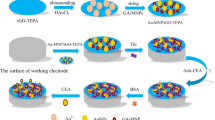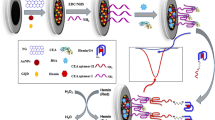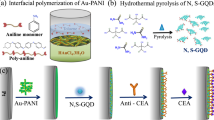Abstract
As well known, the electrochemiluminescence (ECL) of tris(2,2′-bipyridine)ruthenium(ii) (Ru(bpy)32+) heavily relies on highly positive or negative triggered voltage, prejudicing the detection toward the bio-molecules. In this work, Ru(bpy)32+ could generate enhanced and stable ECL at a low potential of 0.05 V (vs. Ag/AgCl) on graphene-PtPd hybrid, attributing to its excellent electrocatalysis from the synergistic effect between Pt and Pd. The obtained low-potential-driven ECL could be quenched by MoS2 nanoflowers. Based on the quenching effect, a sandwich “signal-off” ECL immunosensor was fabricated to sensitively detect carcinoembryonic antigen (CEA). A linear calibration curve from 1 fg mL−1 to 1 ng mL−1 was obtained along with a low detection limit of 0.54 fg mL−1 (S/N = 3) under optimal conditions. The sensor showed satisfactory specificity, stability, and reproducibility and was successfully applied to determine CEA in actual samples. The recoveries ranged from 98.80 to 100.23%, and the relative standard deviation (RSD) was lower than 5%. Above all, this work explored new materials in low-potential-driven ECL system and provided a reliable sensing strategy for clinical applications.
Graphical abstract





Similar content being viewed by others
References
Pei F, Wang P, Ma E, Yu H, Gao C, Yin H, Li Y, Liu Q, Dong Y (2018) A sandwich-type amperometric immunosensor fabricated by Au@Pd NDs/Fe(2+)-CS/PPy NTs and Au NPs/NH2-GS to detect CEA sensitively via two detection methods. Biosens Bioelectron 122:231–238. https://doi.org/10.1016/j.bios.2018.09.065
Wang X, Liao X, Zhang B, Zhang M, Mei L, Wang F, Chen S, Qiao X, Hong C (2021) An electrochemical immunosensor for the detection of carcinoembryonic antigen based on Au/g-C3N4 NSs-modified electrode and CuCo/CNC as signal tag. Microchim Acta 188:408. https://doi.org/10.1007/s00604-021-05013-7
Miao H, Wang L, Zhuo Y, Zhou Z, Yang X (2016) Label-free fluorimetric detection of CEA using carbon dots derived from tomato juice. Biosens Bioelectron 86:83–89. https://doi.org/10.1016/j.bios.2016.06.043
Zhang Y-H, Li M-J, Wang H-J, Yuan R, Wei S-P (2019) Supersensitive photoelectrochemical aptasensor based on Br, N-Codoped TiO2 sensitized by quantum dots. Anal Chem 91:10864–10869. https://doi.org/10.1021/acs.analchem.9b02600
Bai X-R, Wang L-H, Ren J-Q, Bai X-W, Zeng L-W, Shen A-G, Hu J-M (2019) Accurate clinical diagnosis of liver cancer based on simultaneous detection of ternary specific antigens by magnetic induced mixing surface-enhanced raman scattering emissions. Anal Chem 91:2955–2963. https://doi.org/10.1021/acs.analchem.8b05153
Yang T, Fu J, Zheng S, Yao H, Jin Y, Lu Y, Liu H (2018) Biomolecular logic devices based on stimuli-responsive PNIPAM-DNA film electrodes and bioelectrocatalysis of natural DNA with Ru(bpy)32+ as mediator. Biosens Bioelectron 108:62–68. https://doi.org/10.1016/j.bios.2018.02.048
Zhang J, Kerr E, Usman KAS, Doeven EH, Francis PS, Henderson LC, Razal JM (2020) Cathodic electrogenerated chemiluminescence of tris(2,2′-bipyridine)ruthenium(ii) and peroxydisulfate at pure Ti3C2Tx MXene electrodes. Chem Commun 56:10022–10025. https://doi.org/10.1039/D0CC02993A
Li H, Lv W, Yang Q, Li Q, Li F (2021) Inorganic recognizer-assisted homogeneous electrochemiluminescence determination of organophosphorus pesticides via target-controlled emitter release. J Agric Food Chem 69:6087–6095. https://doi.org/10.1021/acs.jafc.1c01006
Ma C, Cao Y, Gou X, Zhu JJ (2020) Recent progress in electrochemiluminescence sensing and imaging. Anal Chem 92:431–454. https://doi.org/10.1021/acs.analchem.9b04947
Han J, Li M, Li H, Li C, Ye J, Yang B (2020) Pt-poly(L-lactic acid) microelectrode-based microsensor for in situ glucose detection in sweat. Biosens Bioelectron 170:112675. https://doi.org/10.1016/j.bios.2020.112675
Li J, Xie H (2013) Enhanced electrocatalytic oxidation of hydroxylamine on Pt/polypyrrole composite modified glassy carbon electrode. Ionics 19:105–112. https://doi.org/10.1007/s11581-012-0711-2
Pei Y, Hu M, Xia Y, Huang W, Li Z, Chen S (2020) Electrochemical preparation of Pt nanoparticles modified nanoporous gold electrode with highly rough surface for efficient determination of hydrazine. Sens Actuators B Chem 304:127416. https://doi.org/10.1016/j.snb.2019.127416
Zhao X-H, Shang L, Zhang W, Jia L-P, Ma R-N, Wang H-S (2021) Sensitive detection of carcinoembryonic antigen based on a low-potential-triggered electrochemiluminescence of tris(2,2′-bipyridine)ruthenium(II) with oxalate as coreactant. J Electroanal Chem 895:115392. https://doi.org/10.1016/j.jelechem.2021.115392
Li M, Bo X, Zhang Y, Han C, Guo L (2014) One-pot ionic liquid-assisted synthesis of highly dispersed PtPd nanoparticles/reduced graphene oxide composites for nonenzymatic glucose detection. Biosens Bioelectron 56:223–230. https://doi.org/10.1016/j.bios.2014.01.030
Sun X, Guo S, Liu Y, Sun S (2012) Dumbbell-like PtPd–Fe3O4 nanoparticles for enhanced electrochemical detection of H2O2. Nano Lett 12:4859–4863. https://doi.org/10.1021/nl302358e
Xie S, Choi S-I, Lu N, Roling LT, Herron JA, Zhang L, Park J, Wang J, Kim MJ, Xie Z, Mavrikakis M, Xia Y (2014) Atomic layer-by-layer deposition of Pt on Pd nanocubes for catalysts with enhanced activity and durability toward oxygen reduction. Nano Lett 14:3570–3576. https://doi.org/10.1021/nl501205j
Zhao X, Chen S, Fang Z, Ding J, Sang W, Wang Y, Zhao J, Peng Z, Zeng J (2015) Octahedral Pd@Pt1.8Ni Core–shell nanocrystals with ultrathin PtNi alloy shells as active catalysts for oxygen reduction reaction. J Am Chem Soc 137:2804–2807. https://doi.org/10.1021/ja511596c
Wang W, Wang Z, Wang J, Zhong C-J, Liu C-J (2017) Highly active and stable Pt–Pd alloy catalysts synthesized by room-temperature electron reduction for oxygen reduction reaction. Adv Sci 4:1600486. https://doi.org/10.1002/advs.201600486
Wang B, Zhong X, Chai Y, Yuan R (2017) An ECL biosensor for sensitive detection of concanavalin A based on the ECL quenching of Ru complex by MoS2 nanoflower. Sens Actuators B Chem 245:247–255. https://doi.org/10.1016/j.snb.2017.01.180
Ma L, Bai L, Zhao M, Zhou J, Chen Y, Mu Z (2019) An electrochemical aptasensor for highly sensitive detection of zearalenone based on PEI-MoS2-MWCNTs nanocomposite for signal enhancement. Anal Chim Acta 1060:71–78. https://doi.org/10.1016/j.aca.2019.02.012
Horak J, Dincer C, Qelibari E, Bakirci H, Urban G (2015) Polymer-modified microfluidic immunochip for enhanced electrochemical detection of troponin I. Sens Actuators B Chem 209:478–485. https://doi.org/10.1016/j.snb.2014.12.006
Liu Y, Wang H, Huang J, Yang J, Liu B, Yang P (2009) Microchip-based ELISA strategy for the detection of low-level disease biomarker in serum. Anal Chim Acta 650:77–82. https://doi.org/10.1016/j.aca.2009.06.048
Shang L, Wang X, Zhang W, Jia L-P, Ma R-N, Jia W-L, Wang H-S (2020) A dual-potential electrochemiluminescence sensor for ratiometric detection of carcinoembryonic antigen based on single luminophor. Sens Actuators B Chem 325:128776. https://doi.org/10.1016/j.snb.2020.128776
Xu S, Liu Y, Wang T, Li J (2011) Positive potential operation of a cathodic electrogenerated chemiluminescence immunosensor based on luminol and graphene for cancer biomarker detection. Anal Chem 83:3817–3823. https://doi.org/10.1021/ac200237j
Abraham BG, Bhaskaran R, Chetty R (2020) Electrodeposited bimetallic (PtPd, PtRu, PtSn) catalysts on titanium support for methanol oxidation in direct methanol fuel cells. J Electrochem Soc 167:024512. https://doi.org/10.1149/1945-7111/ab6a7d
Sun Y, Zheng H, Wang C, Yang M, Zhou A, Duan H (2016) Ultrasonic-electrodeposition of PtPd alloy nanoparticles on ionic liquid-functionalized graphene paper: towards a flexible and versatile nanohybrid electrode. Nanoscale 8:1523–1534. https://doi.org/10.1039/C5NR06912B
Vinoth V, Pugazhenthiran N, Viswanathan Mangalaraja R, Syed A, Marraiki N, Valdés H, Anandan S (2020) Development of an electrochemical enzyme-free glucose sensor based on self-assembled Pt–Pd bimetallic nanosuperlattices. Analyst 145:7898–7906. https://doi.org/10.1039/D0AN01526A
Chang F, Bai Z, Li M, Ren M, Liu T, Yang L, Zhong C-J, Lu J (2020) Strain-modulated platinum–palladium nanowires for oxygen reduction reaction. Nano Lett 12:1538–1544. https://doi.org/10.1021/nl2043612
Miao W (2008) Electrogenerated chemiluminescence and its biorelated applications. Chem Rev 108:2506–2553. https://doi.org/10.1021/cr068083a
Vassilyev YB, Khazova OA, Nikolaeva NN (1985) Kinetics and mechanism of glucose electrooxidation on different electrode-catalysts: Part II. Effect of the nature of the electrode and the electrooxidation mechanism. J Electroanal Chem 196:127–144. https://doi.org/10.1016/0022-0728(85)85085-3
Zhu X, Zhai Q, Gu W, Li J, Wang E (2017) High-sensitivity electrochemiluminescence probe with molybdenum carbides as nanocarriers for α-fetoprotein sensing. Anal Chem 89:12108–12114. https://doi.org/10.1021/acs.analchem.7b02701
Zhang Y, Guo G, Zhao F, Mo Z, Xiao F, Zeng B (2010) A novel glucose biosensor based on glucose oxidase immobilized on AuPt nanoparticle – carbon nanotube – ionic liquid hybrid coated electrode. Electroanalysis 22:223–228. https://doi.org/10.1002/elan.200900306
Wei Y, Ma H, Ren X, Ding C, Wang H, Sun X, Du B, Zhang Y, Wei Q (2018) A dual-signaling electrochemical ratiometric method for sensitive detection of carcinoembryonic antigen based on Au-Cu2S-CuS/graphene and Au-CeO2 supported toluidine blue complex. Sens Actuators B Chem 256:504–511. https://doi.org/10.1016/j.snb.2017.10.136
Wei X-h, Qiao X, Fan J, Hao Y-q, Zhang Y-t, Zhou Y-l, Xu M-t (2021) A label-free ECL aptasensor for sensitive detection of carcinoembryonic antigen based on CdS QDs@MOF and TEOA@Au as bi-coreactants of Ru(bpy)32+. Microchem J: 106910. https://doi.org/10.1016/j.microc.2021.106910
Jozghorbani M, Fathi M, Kazemi SH, Alinejadian N (2021) Determination of carcinoembryonic antigen as a tumor marker using a novel graphene-based label-free electrochemical immunosensor. Anal Biochem 613:114017. https://doi.org/10.1016/j.ab.2020.114017
Funding
This work was supported by Natural Science Foundation of Shandong Province (ZR2018BB059) and the Young Innovative Talents Introduction and Cultivation Program for Colleges and Universities of Shandong Province: Innovative Research Team on Biomedical Sensing and Food Safety Research.
Author information
Authors and Affiliations
Corresponding authors
Ethics declarations
Conflict of interest
The authors declare no competing interests.
Additional information
Publisher’s note
Springer Nature remains neutral with regard to jurisdictional claims in published maps and institutional affiliations.
Supplementary Information
Below is the link to the electronic supplementary material.
Rights and permissions
About this article
Cite this article
Shang, L., Zhao, XH., Zhang, W. et al. Graphene-PtPd nanocomposite for low-potential-driven electrochemiluminescent determination of carcinoembryonic antigen using Ru(bpy)32+. Microchim Acta 189, 17 (2022). https://doi.org/10.1007/s00604-021-05120-5
Received:
Accepted:
Published:
DOI: https://doi.org/10.1007/s00604-021-05120-5




